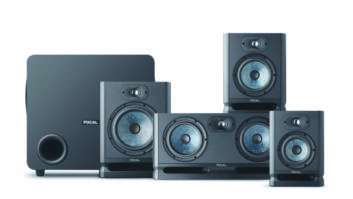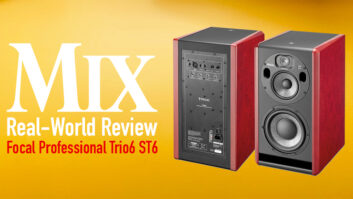
Having established itself as a respected manufacturer of pro studio monitors, Focal recently turned its attention toward creating speakers for musicians and home studio owners. The result is the Alpha Series, a line of three active, two-way near-field monitors. Differences between the models are based primarily on cabinet and woofer size, amplification and maximum SPL. At the top of the series is the Alpha 80 reviewed here.
Inside and Out
The Alpha 80 provides a frequency response reaching down to 35 Hz and a maximum SPL of 109 dB at one meter, which should be loud enough for anyone with common sense. Power is supplied via Class-A/B amplification: 100 watts for the woofer and 40 watts for tweeter.
The Alpha 80 includes an 8-inch low/midrange-frequency driver with a Polyglass cone and a 1-inch aluminum inverted dome tweeter. Focal recommends that the tweeter be situated at ear height, and the cabinet may be oriented upside-down if necessary. The 15mm MDF cabinet is finished with a black laminate and features curved side panels, precluding horizontal placement. At the bottom of the front panel are dual ports and a company logo that doubles as a power indicator.
Rear panel input is via XLR or RCA jacks at +4 dBu or -10 dBV levels, respectively. A 0/+6 dB sensitivity switch can help compensate for sources that don’t have sufficient output to drive the Alpha 80s to max SPL, but it is recommended that sensitivity remain at 0. A power switch turns the unit from Off to Standby; routing audio to the speaker then automatically unmutes the monitor. If the Alpha 80 detects no audio for a period of 30 minutes, it enters Auto Standby mode to conserve power. Two rotary pots enable shelf adjustment of low (+/- 6 dB at 300 Hz) and high (+/- 3 dB at 4.5 kHz) frequencies to compensate for rooms that tilt the spectral balance; the LF control is also useful for trimming the bottom end when the cabinets are placed close to a boundary. An IEC inlet with a fuse holder completes the rear panel.
Into the Studio
I used the Alpha 80s for mixing and tracking, initially placed approximately three feet from the front wall upon stands that decoupled the cabinets from the support platform, and brought the tweeters to ear height (Focal supplies four rubber pads that may be attached to the bottom panel to decouple the cabinet from its stand).
The Alpha 80s are a bit larger than the average 8-inch near-field, and they have a solid build quality, so you’ll want stands that have a sufficiently large platform and provide stable support. I fed audio to the Alpha 80s from either a Dangerous Monitor ST or a MOTU Traveler interface via the XLR inputs (I try to avoid RCA connectors whenever possible), starting with the EQ trims at 0. Both audio inputs are active at all times so you can leave two sources connected, but it is your responsibility to make sure that only one input is feeding audio to the Alpha 80 at any time.
The first thing I noticed was that they throw an extremely stable center image. When I listened to some of my mixes that were in-progress, the lead vocal presence was startling—almost as if there were a center speaker, and delays and reverb could clearly be heard emanating from the left and right sides. The Alpha 80s provided excellent separation and resolution of instruments and vocal parts, and clearly revealed subtle changes in a mix, such as a snare reverb that varies when the chorus begins, or a synth doubling up on a bass line.
For most of my sessions the EQ controls remained flat, with the exception of some mix sessions where the speakers were placed against the front wall. For those sessions I placed two GIK Acoustics 244 Bass Traps directly behind the speaker cabinets to reduce reflections. The manual states that the LF shelf should be reduced a few dB for such placement, and Focal’s advice is well-taken: bottom end was overblown when the cabinets were against the wall, but changing the LF control to -2 or -3 dB cleaned this up, along with improved clarity between kick, bass and toms. I actually preferred this arrangement more than placing the speakers several feet from the front wall. I’d like to have click-stops on the EQ trim controls, not so much for repeatability but for confidence that both speakers are set the same. Regardless of placement, I felt that the Alpha 80’s robust bass response occasionally caused me to mix vocals a hair louder than they needed to be once I heard them on other systems.
The Alpha 80’s bottom is balanced nicely by the inverted dome tweeter, which produced crisp and clear highs, revealing sibilance when it was present on vocal tracks but never causing ear fatigue. The HF shelf control is subtle, operating over a range of only ±3 dB—which I consider a good thing because even if you crank the HF control to maximum you won’t take someone’s head off with excessive high end, or create problems with the mix translating to other systems. Having said that, I left it flat.
Sonically Consistent
I loved that even though the Alpha 80s have the ability to play way louder than my taste, their timbre maintains consistency at low volumes. When played quietly (80 dB SPL), you don’t feel like you’re missing anything. You can still hear thump and get a sense of size from the kick drum and bass without it sounding sloppy. My mixes were rich in the bottom when played on other playback systems, with a “rightness” in the bottom-end balance between kick drum and bass. Focal’s spec for the LF response is accurate and not just an optimistic estimate. I measured a usable response down to 35 Hz—though output dropped off very quickly below that (barely audible at 31.5 Hz).
Something to Love
The Alpha 80 meets Focal’s goal of creating a musician-friendly monitor that excels in low-frequency reproduction and should play loud enough to rouse the neighbors. The cabinets are a hair on the large side compared to other near-fields employing 8-inch drivers, but don’t confuse the Alpha 80 with a boom box—there’s way more here, including a smooth, accurate midrange, stable imaging and the ability to tailor the monitor’s response to complement its surroundings. The onboard amplification provides plenty of headroom, even when running loud (mid-90 SPLs). Other monitors at a similar price point don’t offer the extended low-end reproduction of the Alpha 80. If that’s an important part of your work, you definitely need an audition.
Steve La Cerra is a New York–based recording and live sound engineer.
Try This
The Alpha 80’s amplification circuitry incorporates high- and low-shelf equalization controls to help compensate for placement, or for listening environments that unfavorably impact the speaker’s tonal balance. When the speakers are placed against the front wall of the listening room, an unwanted boost in low-frequency content may result due to reflections from that wall. To compensate and correct for this, use the Alpha 80’s LF Shelf (300 Hz) control. Setting it to -3 dB for placement against a wall, or -6 dB for placement near a corner should restore the speaker’s natural tonal balance.
Product Summary
COMPANY: Focal
PRODUCT: Alpha 80 active near-field monitor
WEBSITE: www.focal.com
PRICE: $599 each
PROS: Extended low-frequency response. Maintains tonal balance at low listening levels. Solid imaging.
CONS: No detents on EQ trim controls. Auto Standby may not be defeated. It ain’t winning any beauty contests.







